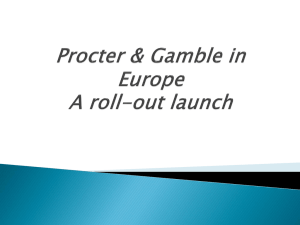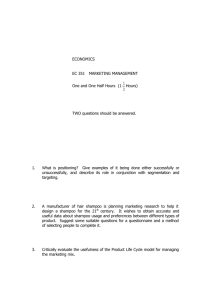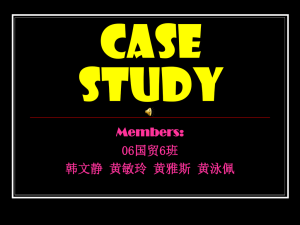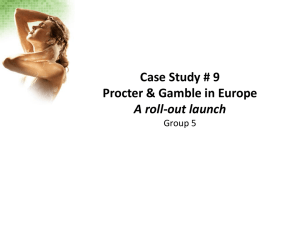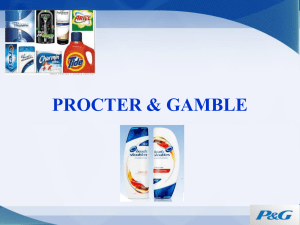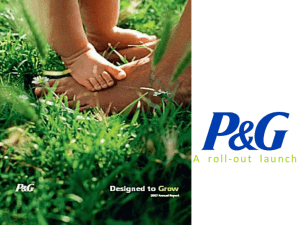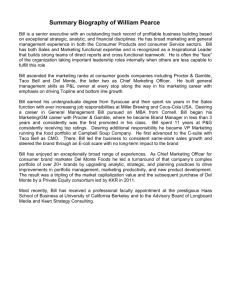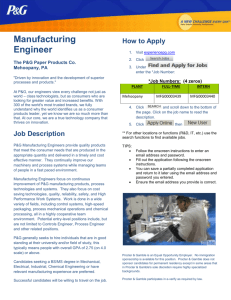Procter & Gamble in Europe A roll-out launch Designing and Managing
advertisement
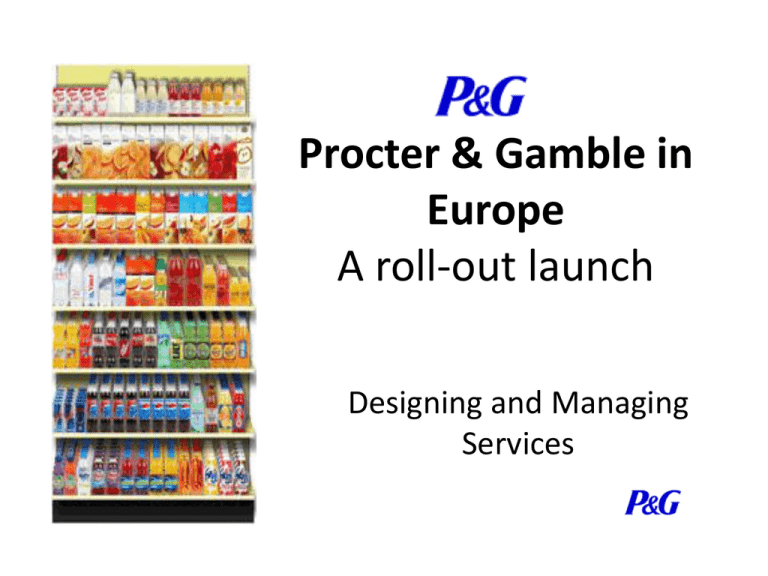
Procter & Gamble in Europe A roll-out launch Designing and Managing Services Group 3 - Members My M987Z247 Eli M987Z254 Ocha M987Z212 Fernando M987Z257 Loan – M987Z234 Joice M987Z224 Outline • • • • • • • • • • • • • • • • • Company’s History Vision and Promise Company’s Value P&G Social Responsibility Product Company’s Achievement Company’s Top Competitors The BC-18 in USA Market Target Group Long-term Marketing Objectives in EU Market 1st Year Marketing Objectives in EU Market Price Short-term Objectives Long-term Objectives Product Development Promoting and Advertising Media Tools Company’s History • On October 31, 1837, Procter & Gamble (P&G) was founded by the two brothers in law William Procter and James Gamble. P&G began as a small, family-operated soap and candle company. • As their purpose to provide products and services of superior quality and values. In 1858-1859, sales reached $1 million. By this point, approximately 80 employees worked for Procter & Gamble. • During the American Civil War, the company won contracts to supply the Union Army with soap and candles. In addition to the increased profits experienced during the war, the military contracts introduced soldiers from all over the country to Procter & Gamble's products. • In the 1880s, P&G began to market a new product, an inexpensive soap that floats in water. • In 1887, William Arnett Procter, William Procter's grandson, began a profit-sharing program for the company's workforce. • In 1911, P&G’s products began to be diversified producing Crisco, a shortening made of vegetables oils rather than animal fats. • In 1920s and 1930s, the company sponsored a number of radio programs those became commonly called soap opera. Company’s History • • • • • • • • • In 1930, P&G was becoming an international corporation with its acquisition Thomas Hedley Co., based in England. In 1946, The company introduced “Tide” laundry detergent. In 1947, P&G produced “Prell” shampoo. In 1955, Procter & Gamble began selling the first toothpaste In 1957, the company purchased Charmin Paper Mills and began manufacturing toilet paper and other paper products. In 1960, Procter & Gamble began making “Downy” Fabric Softener and "Bounce" fabric softener sheets in 1972. In 1961, One of the most revolutionary products to come out on the market was the company's “Pampers”. Procter & Gamble acquired a number of other companies that diversified its product line and significantly increased profits. These acquisitions included Folgers Coffee, Norwich Eaton Pharmaceuticals, Richardson-Vicks, Noxell, Shulton's Old Spice, Max Factor, and the Iams Company, among others. In 1994, the company made headlines for big losses resulting from leveraged positions in interest rate derivatives, and subsequently sued Bankers Trust for fraud; this placed their management in the unusual position of testifying in court that they had entered into transactions that they were not capable of understanding. Company’s History • • • • • In 1996, Procter & Gamble again made headlines when the Food and Drug Administration approved a new product developed by the company, Olestra. Also known by its brand name Olean, Olestra is a lower-calorie substitute for fat in cooking snacks that during its development stages is known to have caused anal leakage and gastrointestinal difficulties in humans. In January 2005 P&G announced an acquisition of Gillette, forming the largest consumer goods company and placing Unilever into second place. This added brands such as Gillette razors, Duracell, Braun, and Oral-B. P&G agreed to sell its SpinBrush battery-operated electric toothbrush business to Church&Dwilight. It also divested Gillette's oral-care toothpaste line, Rembrandt. The deodorant brands Right Guard, Soft & Dry, and Dry Idea were sold to Dial Corporation. The companies officially merged on October 1, 2005. In 2008, P&G branched into the record business with its sponsorship of Tag Records as an endorsement for Tag Body Spray. On August 24, 2009, the Irish-based pharmaceutical company Warner Chilcott announced they had bought P&G's prescription-drug business for $3.1 billion. Vision and Promise The Vision • Be, and be recognized as, the best consumer products and services company in the world. The Promise • More than three billion times a day, P&G brands touch the lives of people around the world. And P&G people work to make sure those brands live up to their promise to make everyday life just a little bit better. Company’s Values Consumer P&G Brands P&G People P&G Values: Integrity Leadership Ownership Passion for winning Trust P&G brands and P&G People are the foundation of P&G success, P&G People bring the values to life as we focus on improving the lives of the world’s consumers. P&G Values • • • • • P&G corporate governance follow some values that allow the company’s employees to have a good environment in their workplace, Such as: Integrity: We always try to do the right thing. Leadership: clear vision of where we are going Ownership: All the employees act like owners, treating the company assets as their own. Passion for winning: determined to be the best. Trust: respect for colleagues, customers and consumers. Company’s Purpose • We will provide branded products and services of superior quality and value that improve the lives of the world’s consumers, now and for generations to come. • As a result, consumers will reward us with leadership sales, profit and value creation, allowing our people, our shareholders, and the communities in which we live and work to prosper. Company’s Principles • We Show Respect for All Individuals We believe that all individuals can and want to contribute to their fullest potential. We value differences. We inspire and enable people to achieve high expectations, standards and challenging goals. We are honest with people about their performance. • The Interests of the Company and the Individual are Inseparable We believe that doing what is right for the business with integrity will lead to mutual success for both the Company and the individual. Our quest for mutual success ties us together. We encourage stock ownership and ownership behavior. • We are Strategically Focused in Our Work We operate against clearly articulated and aligned objectives and strategies. We only do work and only ask for work that adds value to the business. We simplify, standardize and streamline our current work whenever possible. Company’s Principles (cont’d) • • • Innovation is the Cornerstone of Our Success We place great value on big, new consumer innovations. We challenge convention and reinvent the way we do business to better win in the marketplace. We are Externally Focused We develop superior understanding of consumers and their needs. We create and deliver products, packaging and concepts that build winning brand equities. We develop close, mutually productive relationships with our customers and our suppliers. We are good corporate citizens. We incorporate sustainability into our products, packaging and operations. We Value Personal Mastery We believe it is the responsibility of all individuals to continually develop themselves and others. We encourage and expect outstanding technical mastery and executional excellence. Company’s Principles (Cont’d) • • We Seek to be the Best We strive to be the best in all areas of strategic importance to the Company. We benchmark our performance rigorously versus the very best internally and externally. We learn from both our successes and our failures. Mutual Interdependency is a Way of Life We work together with confidence and trust across business units, functions, categories and geographies. We take pride in results from reapplying others’ ideas. We build superior relationships with all the parties who contribute to fulfilling our Corporate Purpose, including our customers, suppliers, universities and governments. P&G Social Responsibility • Being a company that provides products of daily life, must take care of the social responsibility, in two main points. (Customers and it’s employees) • Providing branded products and services of superior quality and value that improve the lives of it's consumers. • Giving a good workplace environment. Product • Air Fresheners • Febreze Air Fresheners • Antiperspirants &Deodorants Old Spice Secret • Baby & Child Care Charmin Children's Pepto Clearblue Easy Dreft Luvs Pampers Pampers Kandoo Pampers UnderJams Puffs • Batteries Duracell Body Wash & Soap Camay Ivory Olay Old Spice Safeguard Zest • Colognes Old Spice • Cosmetics CoverGirl Max Factor • Dish Washing Cascade Dawn Ivory Joy • Feminine Care Always Tampax • Hair Care Aussie Head & Shoulders Herbal Essences Infusium 23 Pantene Product (cont’d) • Hair Color Clairol • Health Care Align Braun Clearblue Easy Metamucil Pepto-Bismol Prilosec OTC Vicks • Household Cleaners Bounty Febreze Air Fresheners Mr. Clean Swiffer • • Laundry & Fabric Care Bounce Cheer Downy Dreft Era Febreze Air Fresheners Gain Ivory Tide Oral Care Braun Crest Crest Glide Crest Whitestrips Fixodent Gleem Scope Oral-B • • Paper Products Bounty Charmin Puffs • Pet Nutrition Eukanuba Iams Snacks Pringles Product (cont’d) • Prestige Fragrances BALDESSARINI BOSS BOSS SKIN bruno banani ESCADA Ghost Giorgio Beverly Hills HUGO LACOSTE NAOMI CAMPBELL PUMA Rochas • Shaving Braun Gillette Fusion Gillette M3Power Gillette SatinCare Gillette Venus • Skin Care Braun Gillette Complete Skincare Olay • Small Appliances Braun Company’s Achievement Company’s Achievement Company’s Achievement Company’s Achievement Company’s Achievement Company’s Top Competitors • • Industries Where The Procter & Gamble Company Competes: – Personal Care Products – Business Services – Commercial Cleaning & Facilities Management Services – Consumer Products Manufacturers – Cleaning Products – Food Analysis of Competitive Landscape of P&G: Demand is driven largely by demographic shifts, particularly trends in population and age, working women, race and ethnicity, household size, and levels of disposable income. The profitability of company depends on a good product mix and efficient operations. Large distributors are advantaged by bulk purchasing and economies of scale in distribution. Smaller companies can compete effectively by specializing in organic, natural, or kosher products or focusing on a geographical area. The BC-18 In USA Market • In 1986 The Company develops a new technology that enables consumers to wash and condition their hair using only one product. Pert Plus/Rejoice shampoo quickly becomes one of the leading worldwide shampoo brands. (BC-18). • The USA shampoo market is highly fragmented, with a large number of suppliers and brands. • To Refresh the shampoo market Pert Plus was divided to launch with BC-18 Tech. • Long-term Marketing goal: to take over the leading value position in the USA shampoo market. The BC-18 In USA Market (cont.) Marketing Objectives: • Market share value in the first year is 5 %. • Market share in the long-term is at least 10 %. • It was positioned as the shampoo that offered attractive hair in a convenient way. The BC-18 In USA Market (cont.) Pert Plus Introductory Activities In the first 12 months In the Following 12 Months •Strong TV advertising, •Sample distribution 60% of household •Listing fund $4 million •10 Normal TV advertising •Sample distribution 10% of households •Display activities in hypermarket Result •In 1987 Vol share 4 % and value share 6.0 %. •In 1988 Vol share 4.5 % and value share 6.3 %. Target Groups - All peoples - Focus on some markets: • West Germany • Great Britain • France • Scandinavia • Benelux Long-term Marketing Objectives in EU Market • Take over the European market. • Increase brand identity of P&G because the value-based market share of a shampoo brand is very important. • Add more brands with BC18 Technology. • Understand well the EU market & competitors. 1st Year Marketing Objectives in EU Market Increase market share in: High share of conditioner market: West Germany, Great Britain, Scandinavia & Benelux. Underdeveloped conditioner market: France (sale volume: 10% of shampoo consumption) & Southern European countries. Price • Research indicates in Europe there are large price differences among hair care products. P&G has decided that it should place the new shampoo in the premium-priced segment; this is done in order to keep up the image of the shampoo as a high quality and innovative product. P&G should charge premium price in each country - to be sold for 4.99 DM for the 200 ml bottle and for 5.99 DM for the 250 ml bottle in all the countries which had had been accepted during the consumer tests. The company cannot charge a price very few people can afford, this will also not be profitable for the company. Short-term Objective The aim of P&G is to become a leader in the European market of two in one hair products: • To attract new European customers who never used conditioner and customers from competing brands to shift to the use of conditioner and/or shampoo to BC-18. • To exert a pull on the population in order to create a new market niche inside the shampoo market and encourage the people to use the new BC-18. • To establish brand loyalty as this will encourage customers to continue buying the product and will enable them to become more familiar with the range of products available at P&G. Long-term Objective • To establish a market share that will expand and gain in recognition. • To increase steadily the market share of the market in Europe. • To ensure that the company benefits from revenues and strengthens its position as a market leader. Product Development • BC-18 technology would offer the European consumers 'Great looking hair in a convenient way. • By introducing a single brand name for its potential market, P&G does not have to create new marketing campaigns for targeted countries. • The company is able to use the brand name of "Vidal Sassoon", which is an already well-known brand name in the United Kingdom, West Germany and Scandinavia and fits to the criteria mentioned above. It is in the upper market segment and has the established image of a high quality product; it would compliment the new BC-18 product. Product Development • Selling its product right away by using the U.S. bottle size of 200ml is a good opportunity for the company as it will be able to see how the market is reacting to the new product and whether sales are reaching expectations. • Design a construction of a new 250ml bottle should nevertheless start right away and it should be introduced as soon as possible to be able to reap in the benefits of economies of scale. • This is constructive as once the new bigger bottles (250ml) are designed P&G can run a promotion campaign for Great Britain and West Germany indicating that consumers can now get 50ml or 25% more. Promotion and Advertising • The promotion campaign will aim to underline and emphasize positive aspects of the new shampoo and conditioner use. • Advertising campaigns explain the advantage conditioner use in general (this will increase conditioner use), and highlight the products practicality. • Using the background voiceovers changing according to language of the county, elements can be changed through the means of air-brush computer software. This will allow the company to cut down on promotional costs. Media Tools • The media plans for the different years show a higher media spending on sampling and TV advertising in the year of introduction to convince customers of the superiority of the new product and to explain its new technology. • TV advertising, at the beginning, is to introduce the product and to gain a significant market share in the first year. It should also be used to maintain the growth of market share in the second year but can be reduced in the third year when the product reaches its mature stage. Answering the Question Question #1 What are the main issues to be considered in balancing a pan European introduction strategy with local market needs? • The possible alternative brand name’s strategy: it’s lucid for the company to choose line extension method, in that the company can coast on the goodwill that it has built up in the category and save the money that it would otherwise have to spend to create brand awareness of a new name and offering. Answering the Question Question #1 • What is the Long term Marketing Objective: Is a continuation of the short-term objective (establish a market share that will expand and gain in recognition). • The alternative possibilities in relation to issues of positioning, target groups, sources of business, pricing strategy and packaging: – Penetration into new geographical territories. – It would ensure the company benefits from revenues and strengthens its position as a market leader. Answering the Question Question #2 First-year marketing objective as a part of short term business strategy is implemented to accomplish the long-term goals. It has to encourage: – Measurability which provides clarity (one of the most powerful forces in business leadership) for the business units involved. – Priority-Centric which considers over budget and resources. – Understandability which make it pretty self-explanatory. – Acceptability which are consistent with preferences and own vision of business units. – Motivating – Flexibility which should be adaptable to unforeseen changes in the business environment. – Link to Long-Term Objectives which help business units gain traction and momentum in the process of accomplishing long-term goals. – Achievability which is closely tied to motivation. If an objective cannot be achieved, employees will burn out quickly move on to a company where they can thrive. Answering The Questions Question # 3 Would you undertake a ‘roll-out’ launch, and if so in what country order? What are the decision criteria for this order? • Because of "a steady growth of the shampoo market and the conditioner market" and statistics show an increase in hair washing, Europe is the attractive market to undertake a ‘roll-out’ launch. • Southern European countries have quite an underdeveloped conditioner market compared to the USA., therefore, P"G should focus upon West Germany, Great Britain, France, Scandinavia and Benelux • The share of shampoo users who also use conditioners reaches almost US standard in Great Britain, with 42%. Germany has the second best user share, followed by Scandinavia and Benelux, where conditioner consumption is almost equal. Therefore, it is advisable to introduce BC-18 simultaneously in these two countries. Answering The Questions Question # 3 • In France, sales volumes for conditioners only make up 10% of those for shampoos. The introduction in Scandinavia, Benelux and France should follow in the second year to avoid competitors' me-too products to be introduced in those markets. • A consumer test in Europe proved that the original US bottle for Pert Plus was the most appealing compared to the alternative products varying in brand name, size and price. 28% would definitely buy it and 70% considered it to be very convincing and relevant. Thus introducing BC-18 into the European market would be rather uncomplicated, this can be seen in the expected sales exhibit, where sufficient production capacity is guaranteed. Answering the Questions Question #4 Taking the country with the highest priority, which principles would you use in order to budget media spending? Set out a rough media plan for the first twelve months, with proposals for promotion activities in the first year. How should media and promotion activities be budgeted for the following years? • We assume that the P&G had a plan to launch the new shampoo product in Hawaii. The proper media plan and advertising is the best tool to give information about product. The company should increase the budget on advertising cost. They have to use both printed and electronic media to reach mass customer. Reach and frequency are key media terms used more in broadcast than in print. Reach is the total number of people exposed to a message at least once in a set time period, usually four weeks. Frequency is the average number of times those people are exposed during that time period. To make reach go up, you buy a wider market area. To make frequency go up, you buy more ads during the time period. Media Plan • January - December 1. Promotion - from flyer (brochure, small leaflet) - from street banner - from held up activity 2. Advertising with media - Print media NT 20,000 (estimated figure) - Radio NT 30,000 (estimated figure) - Television NT 40,000 (estimated figure) - internet NT 15.000 (estimated figure) 3. Promotion activities: P&G will introduce the brand to make people in Hawaii aware about the brand. P&G also will hold some activities, related with health, environment, or government to gain public awareness and build image of the company. The activity like seminar or support sport activities. Answering The Questions Question # 5 Examine the cost and revenue implications of the Europe-wide introduction program. Is there any loss to be expected in the first years? Does this require a modification of the order of local market entries? • As can be seen in the expected sales exhibit, P&G has losses over the first two years. Great Britain and Germany are already profitable after the first year but with the introduction in the other countries in the second year, the gain in Great Britain and Germany will not compensate the losses of the first year and the losses due to the introduction in those countries. • In the third year, all countries, however, will make profits and the company will break even with a total profit of 16.248.900 DM • It is easily to see that the strategies of P&G prove to be effective to the order of local market entries.
